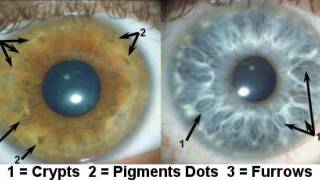Where is the soul? In the eyes, psychologists claim
Source: livescience.com

As the cheesy pickup line suggests, your eyes may really be the window to your soul. According to a new study by Yale University psychologists, most people intuitively feel as if their "self" — otherwise known as their soul, or ego — exists in or near their eyes.
In three experiments, the researchers probed preschoolers’ and adults’ intuitions about the precise location of the self in the body. The participants were shown pictures of cartoon characters, and in each picture a small object (a buzzing fly or snowflake) was positioned near a different section of the character’s body (face or torso or feet, etc.), always at the same distance away.
The study participants were then asked which pictures showed the object closest to the body, the hypothesis being that people would interpret the object as closest when it was near what they intuitively believed to be the soul’s location.
As reported earlier this month in the journal Cognition, the vast majority of the 4-year-olds and adults in the study thought the object was closest to the character when it was near the character’s eyes. This was true even when the cartoon character was a green-skinned alien whose eyes were on its chest rather than in its head – suggesting that it was the eyes, rather than the brain, that seemed most closely tied to the soul.
According to lead researcher Christina Starmans of the Mind and Development Lab at Yale, she and study co-author Paul Bloom designed their experiment after a conversation in which they discussed intuitively feeling as if their consciousnesses were "located" near their eyes, and that objects seemed closest to them when near their eyes. "We set out to test whether this was a universally shared intuition," Starmans told Life’s Little Mysteries.
As it turned out, it was — even among young children.
[Take the test]
"The indirect nature of our method, and the fact that these judgments are shared by adults and preschoolers, suggests that our results do not reflect a culturally learned understanding … but might instead be rooted in a more intuitive or phenomenological sense of where in our bodies we reside," the authors concluded.
However, experts disagreed about the implications of the research. Neurologist Robert Burton, author of numerous books and articles on themind-body connection, thinks the results don’t rule out the possibility that Westerners’ sense that we exist in our eyes is culturally indoctrinated.
Burton, former chief of the division of neurology at University of California, San Francisco-Mount Zion Hospital, said the most interesting result of the study seems to have been brushed under the rug by the researchers: It is that the 4-year-olds and adults didn’t actually give the same responses during the experiment with the alien cartoon character. Almost as many children thought the buzzing fly was closest to the alien when it was near his eyeless head than when it was near his eye-bearing chest. Meanwhile, the adults almost unanimously selected the chest-eyes. "This suggests that something has transpired during the time between age 4 and adulthood that affects our understanding of the identity of other people," Burton said.
In other words, it seems we learn to associate identity with eyes, rather than doing it innately from birth. Perhaps, for example, eyes take on more importance as we develop awareness of the social cues that other people convey with their eyes. Or, perhaps it’s because adults have learned that it’s good etiquette to make eye-contact.
[...]
Read the full article at: livescience.com
Body Language of the Human Eye
By Ariel Lehrer | Blifaloo.com
Is it possible to read someone’s thoughts by gazing into their eyes? What body language cues can we gather just from observing eye movement?

If only you would have known that the funny little emoticons you were drawing when you were a kid would become the big business they are today. Certainly you would have cashed in. Nobody had to tell you that eyebrows angled down meant angry, angled up was sad, arched was surprised. You knew instinctively that eyes have a lot to say about what a person is thinking and feeling.
That’s because the ability to read a person’s intentions based on eye movement develops at about the age of four. But there’s a whole lot more to know about what the eyes have to say than what simple face images can tell.
Right Brained or Left?
The direction of a person’s gaze alone reveals a whole world of what is going on behind the forehead. Conjugate lateral eye movements, or CLEMS, are involuntary eye movements to the left or right and can indicate whether a person is engaged in symbolic or visual thinking. A 1999 study showed that people are predominantly left or right lookers and that 75% of their eye movements will be in one direction or the other. This is a good indication of whether you are dealing with a more analytical left brain person who will mostly look to the right or a creative right brain person who is probably looking to the left.
Lying Eyes
The story changes a little when you are not trying to assess the person’s thought patterns but posing a question directly to them. Blifaloo’s article “Eye Direction and Lying” discusses at greater length determining a person’s truthfulness based on the direction of their gaze. You can tell whether a person is constructing or remembering information by the direction in which they are looking. Meaning, if you ask them to describe an experience and they look up and to the left from your viewpoint, in the direction of visual construction, they are probably making it up rather than remembering. A gaze downward can also indicate guilt or shame because the person knows their statements to be false.
Be careful with these cues. They are indications but they are not foolproof. Dr. Bella DePaulo, a psychologist at the University of Virginia, reported in 1986 that people think that they are much better than they actually are at reading body language. Most people inaccurately believed that “shifty eyes” meant a person was lying. A person’s body language response when defending themselves against the accusation that they have lied is identical to the body language used during lying. Neuro linguistic programming experts (NLP) would caution that the rule of thumb is to use a minimum of four body language cues to make judgments about a person’s thoughts.
The Eyes Link to the Senses
The gaze of a person’s eyes can also tell you whether they are in a visual, auditory, or kinesthetic mode of thinking.
[...]
Read the full article at: blifaloo.com
The Mysterious Pineal Gland - Seat of the Human Soul
By Deborah Bates | Suite101.com
The Pineal Gland, a connection between the physical & spiritual and a source of ethereal energy initiating supernatural powers. Discover more about this mysterious gland.
The size of a pea, the Pineal Gland is shaped like a small pine cone and located directly behind the eyes in a tiny cave at the centre of the brain. As the last endocrine gland discovered, it had the reputation of being a mystery gland shrouded in myth, superstition and metaphysical theories.
Supernatural Powers
Philosophers and Spiritual Adepts have long contemplated the function of the Pineal. For example, the Ancient Greeks believed it to be our connection to the realms of thought and French philosopher Renee Descartes referred to it as the seat of the human soul. Most mystical traditions and esoteric schools have known this area to be the connecting link between the physical and spiritual worlds and consider it a powerful source of ethereal energy initiating supernatural powers. Thus, the hormones released by this gland play a part in the stimulation of the higher-mind and the development of intellectual pursuits. Toxins in this gland indicate the spirit is weak due to lack of will combined with an invasion of the psyche.
[...]
Read the full article at: suite101.com
Also tune into:
Brian Gerrish - Common Purpose & Neuro Linguistic Programming
Gary Schwartz - The Soul Phone & Information from the Other Side
Anthony Peake & Tom Campbell - Consciousness Creates Reality
Peter Smith - Past Life and Life Between Lives Regression
Joe Slate - Psychic Vampires, Energy Predators & Energy of the Soul
Anthony Peake - Hour 2 - The Pineal Gland & DMT Experiences
Anthony Peake - Mystery of the Brain, Precognition, Time Dilation & Déjà vu
Marcel Kuijsten - Julian Jaynes, the Bicameral Mind & The Origin of Consciousness






















